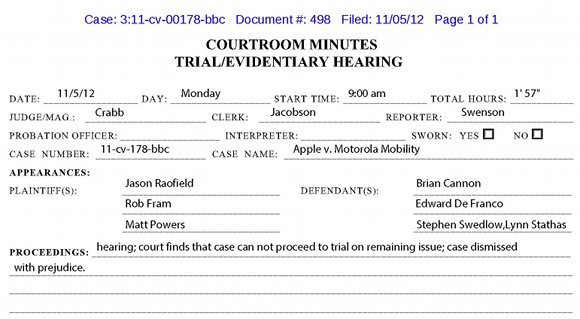 A federal court dismissed Apple’s fair, reasonable, and non-discriminatory (FRAND) patent licensing claims against Motorola Mobility, Inc. this morning.
A federal court dismissed Apple’s fair, reasonable, and non-discriminatory (FRAND) patent licensing claims against Motorola Mobility, Inc. this morning.
The case was dismissed ‘with prejudice,’ legalese that means Apple’s claims that the court threw out cannot be raised a second time in a different lawsuit.
A once sentence transcript of minutes from this morning’s 2 hour and 37 minute court hearing is succinct and to the point (read it below):

The exact reasons behind the court’s decision to dismiss this case will hopefully become clear after the court adds a detailed written opinion to the case docket detailing its legal reasoning behind.
Last week this blogger noted that FRAND disputes were being pursued in parallel litigation tracks in the U.S. and abroad.
On October 31, 2012, Apple declared told the court and Motorola Mobility that its competitor’s essential wireless patents in dispute are worth, at most, just one dollar per iPhone.
There were at least six lawyers at this morning’s hearing before U.S. District Judge Barbara B. Crabb in the Western District of Wisconsin — three for Apple and three for Motorola Mobility.

 On Monday, Apple filed an
On Monday, Apple filed an  Enough already! That’s the message from Judge Richard Posner, the federal judge presiding over one of
Enough already! That’s the message from Judge Richard Posner, the federal judge presiding over one of 